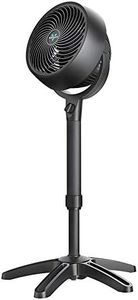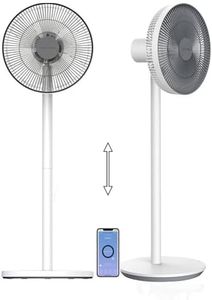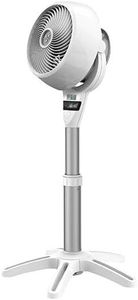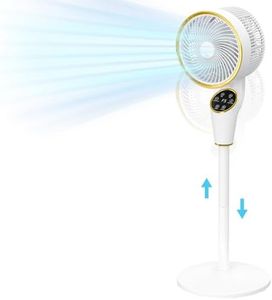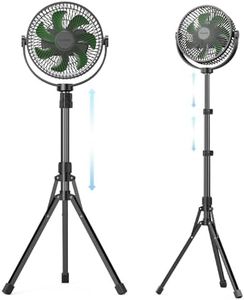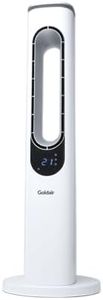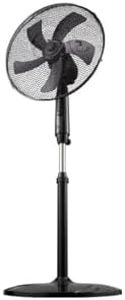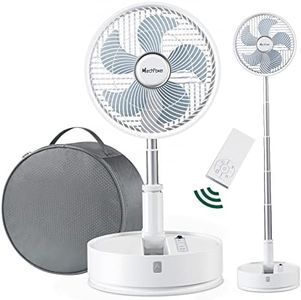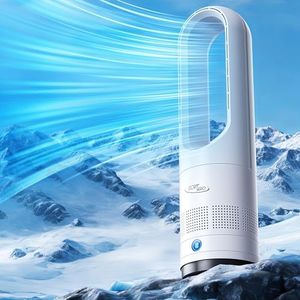We Use CookiesWe use cookies to enhance the security, performance,
functionality and for analytical and promotional activities. By continuing to browse this site you
are agreeing to our privacy policy
10 Best Floor Standing Fans
From leading brands and best sellers available on the web.Buying Guide for the Best Floor Standing Fans
Choosing a floor-standing fan can make a big difference in your comfort during warmer months. The right fan will not only help cool your space, but can also improve air circulation and make your environment more pleasant. When shopping, consider where you want to use the fan—like bedrooms, offices, or living rooms—and think about the features that will suit your needs best. Understanding the key specifications will help you pick a fan that matches your space, personal preferences, and lifestyle.Airflow (CFM)Airflow, usually measured in cubic feet per minute (CFM), tells you how much air the fan can move. This is important because higher airflow means the fan can cool larger rooms more effectively. For small bedrooms, a lower CFM may be sufficient, making the fan quieter and more gentle. For bigger spaces like living rooms or workshops, you'll want higher CFM for stronger and broader airflow. Figure out the size of the area you want to cool, and use that as a guide—smaller fans for smaller rooms, larger for spacious areas.
Fan Size (Blade Diameter)The size of the fan, often given as the blade diameter in inches, affects how much air it can move and how much space it occupies. Smaller fans (around 12-16 inches) are great for personal cooling or tighter spaces. Medium sizes (16-18 inches) suit average rooms, while larger fans (18 inches and above) are ideal for larger areas or shared spaces. Choose the size based on both the size of your room and how portable you want the fan to be.
Speed SettingsSpeed settings allow you to adjust how fast the blades spin, which affects how much air is moved and the noise level. More speed options give greater flexibility—you can keep it gentle at night or powerful during the hottest parts of the day. Fans with three or more speeds give you more control, while models with just two speeds are simpler but less adjustable. Consider your comfort needs—do you like a light breeze or strong airflow?
OscillationOscillation means the fan head moves side-to-side, spreading air over a wider area. This is useful for cooling more than one person or providing even air circulation. Some fans offer adjustable or wide-angle oscillation, while others are fixed. If you want to cool a group or a whole room, look for this feature. If the fan will mostly point directly at one person or spot, it might not be as important.
Noise LevelNoise level tells you how loud the fan is when running, and it's usually measured in decibels (dB). Quiet fans are essential for bedrooms or offices where you need low distraction. Some fans have 'silent' or 'sleep' modes for minimal noise at night. If you are sensitive to noise, check for models with lower dB ratings or special quiet features. Louder fans might be acceptable for living rooms or workshops where background noise is less of a concern.
Height AdjustabilityHeight adjustability means you can change how tall the fan stands, offering flexibility in directing airflow. Adjustable fans can be set lower for sitting areas or higher to reach over furniture. If you want to use your fan in different spots or for different needs, pick one with an easy-to-use height adjustment.
Control Method (Manual, Remote, Smart)Control method refers to how you turn on, adjust, or set the fan. Manual controls are basic switches or dials on the fan itself, which are simple but require you to be nearby. Remote controls let you adjust settings from a distance—really handy in larger rooms or bedrooms. Some modern fans also offer smart controls that work with apps or voice assistants for even more convenience. Think about how you’d like to control your fan: simplicity, ease of use, or advanced tech features.
Additional Features (Timer, Air Purification, Ionizer)Some floor-standing fans include extra features like a programmable timer (to turn off after a set period), air purification or ionizer functions (to help reduce allergens and dust), or even humidifying options. These can add comfort and convenience, especially if you have allergies or want the fan to turn off automatically at night. Decide which of these extras fit your lifestyle, but remember that more features can sometimes make operation more complicated.



